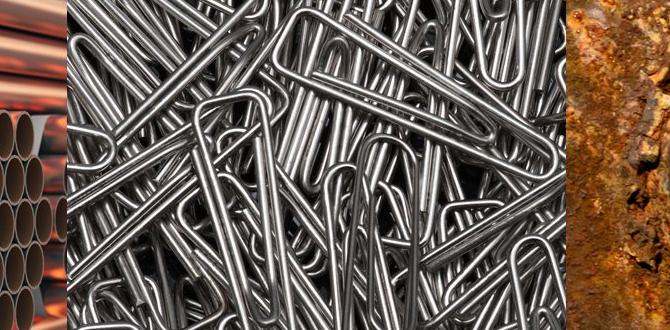A 1/8-inch carbide end mill is a fantastic choice for detailed wood cutting, offering precision and durability for intricate projects. Its small size allows for fine details, while carbide ensures it stays sharp through tough woods. Properly used, it’s your secret weapon for professional-looking results in your workshop.
Hey there, fellow makers! Daniel Bates here, your guide from Lathe Hub. Ever stared at a piece of beautiful wood and wished you could carve impossibly fine details into it? Maybe you’ve tried standard router bits and found them too chunky for the delicate work you envision? It’s a common hurdle for many woodworkers and hobbyists, especially when you’re looking to achieve that next level of precision without spending a fortune or wrestling with overly complex machinery. The good news is, there’s a simple, effective solution hiding in plain sight: the humble 1/8-inch carbide end mill. Don’t let the “metalworking” name fool you; these little powerhouses are incredibly versatile and can bring your woodworking visions to life. Get ready to discover how this specific tool can become your new best friend for intricate cuts and detailed designs.
Why a 1/8-Inch Carbide End Mill is a Woodworker’s Dream
When we talk about end mills, many people immediately think of metal shops and heavy machinery. While they are indeed fundamental in metal fabrication, their precision and durability make them surprisingly effective and often superior for certain woodworking tasks. Specifically, the 1/8-inch carbide end mill offers a unique combination of attributes that make it a standout choice for anyone looking to elevate their woodcraft.
Think about those intricate scrollwork patterns, delicate lettering on signs, or even the fine details on custom furniture. These are the tasks where standard woodworking tools can sometimes fall short. Router bits, while excellent for larger profiles and general routing, often have a larger diameter and can be less forgiving for very fine work. This is where the 1/8-inch carbide end mill shines.
Its small diameter is perfect for creating narrow grooves, sharp internal corners, and precise outlines. Imagine engraving fine lines on a wooden keepsake box or cutting out tiny, intricate shapes for a model. The 1/8-inch size allows for this level of detail without hogging away too much material or causing splintering. Furthermore, the “carbide” part of the name is crucial. Carbide is an extremely hard and wear-resistant material, meaning these end mills stay sharp much, much longer than high-speed steel (HSS) bits. This translates to cleaner cuts, less tear-out, and a consistent performance even when working with tougher hardwoods. For beginners, this means fewer frustrations with dulling tools and more time spent enjoying the creative process.
Understanding the Carbide End Mill Terminology
Before we dive into how to use it, let’s quickly break down what makes up the name “carbide end mill 1/8 inch.” Understanding these terms will help you choose the right tool and understand its capabilities.
- Carbide: This refers to the material the cutting edges of the end mill are made from. Tungsten carbide is a composite material that is incredibly hard and durable, far more so than typical steel. This hardness allows it to cut through tough materials like hardwoods with ease and maintain its sharpness for extended periods.
- End Mill: This is a type of rotary cutting tool used in milling operations. Unlike a drill bit that primarily cuts downwards, an end mill can cut sideways (laterally) as well as downwards. It has cutting edges on its circumference as well as on its tip.
- 1/8 Inch: This is the diameter of the cutting portion of the end mill. A 1/8-inch end mill is quite small, making it ideal for fine detail work.
- Shank: The shank is the part of the end mill that is held by the tool holder or collet. While many end mills have a 1/8-inch shank to match their cutting diameter, you’ll sometimes see variations. For instance, a “1/8 inch end mill 10mm shank” means the cutting diameter is 1/8 inch (about 3.175mm), but the shank diameter is 10mm (about 0.39 inches). This is often seen on tools designed for specific CNC machines or collets.
- Extra Long: This indicates the flute length (the part with the spiral cutting edges) and/or the overall length of the end mill is longer than standard. This can be beneficial for reaching into deeper cuts or working on thicker materials.
- For Wood: While end mills are primarily associated with metal, specialized ones, or those with specific flute designs, are optimized for cutting wood. These often have fewer flutes (cutting edges) and a sharper cutting angle to prevent chip buildup and create cleaner cuts in wood.
- Low Runout: “Runout” refers to the deviation from perfect rotation. Low runout means the end mill spins very true to its axis, minimizing wobble. This is crucial for precision work, ensuring your cuts are exactly where you intend them to be, without unwanted widening or inaccuracies.
When to Reach for Your 1/8-Inch Carbide End Mill
This little tool isn’t meant to replace your larger router bits or standard woodworking tools, but rather to complement them for specific tasks requiring finesse and accuracy. Here are some prime examples where a 1/8-inch carbide end mill will prove invaluable:
- Intricate Engraving: Creating detailed text, decorative patterns, or fine lines on signs, awards, or custom projects.
- Small Component Machining: Cutting out small, detailed shapes for inlays, models, or decorative elements where precision is paramount.
- Detailed Carving: Adding fine textures, sharp edges, or intricate details to carvings that would be difficult or impossible with larger tools.
- V-Carving: When used on a CNC machine, a 1/8-inch end mill is excellent for creating sharp, clean V-grooves for lettering or decorative channels.
- Creating Small Slots or Grooves: Machining narrow slots for joinery, decorative elements, or functional purposes where a precise width is needed.
- Chamfering Small Edges: While not its primary purpose, it can be used at an angle to create very small, precise chamfers on delicate pieces.
- Working with Delicate Woods: The sharpness and precision of a carbide end mill can minimize tear-out, even in softer or more fibrous woods.
Choosing the Right 1/8-Inch Carbide End Mill for Wood
Not all 1/8-inch carbide end mills are created equal, especially when it comes to wood. Here’s what to look for:
Types of End Mills Based on Flutes:
The number of flutes (the spiral grooves that cut) significantly impacts performance in wood.
- 2-Flute End Mills: These are generally the best choice for wood. With fewer cutting edges, they create larger chip pockets, allowing wood chips to evacuate more easily. This is crucial for preventing chip buildup, overheating, and a rough finish. They are ideal for profiling, slotting, and general wood cutting.
- 4-Flute End Mills: While more common for plastics and metals, 4-flute end mills can be used in wood for finishing passes at higher speeds. They provide a smoother surface finish because more teeth are engaged at once. However, they are more prone to chip clogging in softer woods and at lower speeds.
Material and Coating Considerations:
As mentioned, carbide is key for durability and sharpness. For wood, standard solid carbide is usually sufficient. Coatings aren’t as critical as they are for metal, as the primary challenge in wood is chip evacuation and avoiding burning, not extreme heat from friction against dense metal.
Shank Diameter:
Most 1/8-inch diameter end mills will have a 1/8-inch shank for easy use with standard trim routers or CNC collets. However, if you have a specific CNC spindle or collet set, you might encounter tools with different shank sizes, like the 10mm shank example. Always ensure your collet matches the shank diameter of your end mill to prevent wobble and ensure a secure grip.
Straight vs. Spiral Flutes:
For wood, you’ll almost always encounter spiral flutes, which are essential for lifting chips out of the cut. End mills are defined by these spiral flutes.
Common Pitfalls to Avoid When Selecting:
- End Mills Designed for Metal: While they can cut wood, end mills with very fine, closely spaced flutes designed for metal might clog easily and lead to overheating or burning in wood.
- Too Many Flutes: As noted, avoid end mills with a higher flute count (like 6 or more) for general woodworking unless you understand their specific finishing applications.
- Poor Quality Carbide: Cheaply made end mills might chip easily or not hold an edge for long, negating the benefits of carbide.
A good starting point for most wood cutting tasks is a 1/8-inch diameter, 2-flute solid carbide end mill with a straight 1/8-inch shank. If you encounter the “extra long” or specific shank sizes, ensure they fit your setup and needs.
Tools and Setup for Using Your 1/8-Inch Carbide End Mill
To safely and effectively use a 1/8-inch carbide end mill, you’ll need a few key pieces of equipment:
Essential Tools:
- Rotary Tool or Trim Router: A Dremel-type rotary tool with a proper collet adapter for a 1/8-inch shank is a common entry point for detailed hand-held work. For more power and stability, a small trim router with a 1/8-inch collet is ideal for CNC machines or handheld applications.
- Collets: These are precision-ground sleeves that fit into your tool’s chuck and grip the end mill shank. You must have the correct size collet (e.g., 1/8 inch) that matches your end mill’s shank diameter. Using the wrong size collet or adapters can lead to runout, poor cuts, and dangerous situations.
- CNC Machine (Optional): For maximum precision and repeatability, especially for intricate designs or repetitive tasks, a small desktop CNC router is where these end mills truly shine.
- Workbench and Clamping System: A stable workbench along with clamps, vises, or a sacrificial spoilboard (for CNC) is essential to hold your workpiece securely.
Workpiece Holding:
This is non-negotiable for safety and accuracy. Your wood must not move during the cut. Use robust clamps, double-sided tape (for lighter jobs), or a vacuum table if you’re using a CNC.
Safety Gear:
Always prioritize safety. Wood dust and flying debris are significant hazards. At a minimum, you’ll need:
- Safety Glasses or Face Shield: To protect your eyes from dust and chips.
- Dust Mask or Respirator: Wood dust can be harmful to your lungs.
- Hearing Protection: Rotary tools and routers can be loud.
Workpiece Preparation:
Ensure your wood is flat, dimensioned to the correct thickness, and free of debris. For CNC work, a perfectly flat spoilboard is crucial for consistent cutting depth.
Step-by-Step Guide: Using Your 1/8-Inch Carbide End Mill for Wood
Let’s get practical. Here’s how to use your 1/8-inch carbide end mill to create some detailed cuts.
Step 1: Secure Your Workpiece
As mentioned, this is crucial. Place your wood on a stable surface. Use clamps, a vise, or a secure hold-down method to ensure the wood will not shift at all during the cutting process. For CNC, this means using clamps, double-sided tape, or your machine’s hold-down system on a flat spoilboard.
Step 2: Install the End Mill
Ensure your rotary tool or router is unplugged or powered off. Insert the correct collet into the tool’s chuck. Then, insert the 1/8-inch shank of your carbide end mill into the collet. Tighten the collet securely. Make sure the end mill is inserted deep enough to be held firmly, but not so deep that the unground shank is engaged in the cut (if applicable to your tool). A good rule of thumb is to have at least half the shank length engaged in the collet.
Step 3: Set Up Your Tool and Depth
If using a handheld tool, a steady hand and support are key. For CNC, you’ll establish your Z-axis zero point.
For handheld: Position the tool over your starting point. Gradually lower the spinning end mill into the wood.
For CNC: Use your machine’s software to define the cutting path and the depth of cut. Do not attempt to cut the full depth of your material in one pass. It’s always better to make multiple lighter passes.
Step 4: Make the Cut
- Handheld: Move the tool smoothly and deliberately along your intended path. Let the end mill do the work; don’t force it. Guide the tool with steady pressure. Work in a direction that pushes chips away from your path and avoids climbing (where the tool pulls itself into the material against the direction of rotation). This usually means moving the router from right to left if the cutting edge is on the right side of the spinning tool.
- CNC: Start your program. Monitor the cut for any signs of trouble like excessive noise, smoke, or chip buildup.
Step 5: Chip Evacuation and Cooling
Wood chips can clog the flutes and cause burning. If working handheld, use a brush or vacuum to clear chips periodically. For CNC, ensure your dust collection system is effective. You might also use compressed air to blow chips out of the cutting area. As carbide is very hard, it can tolerate higher speeds, but excessive heat can still be an issue in wood, leading to burning.
Step 6: Multiple Passes for Depth
For any significant depth, plan for multiple shallow passes rather than one deep cut. A common recommendation for hardwoods is to not cut deeper than the diameter of the end mill in a single pass. So, for a 1/8-inch end mill, aim for 1/16 inch or less per pass. This reduces stress on the tool, your machine, and the wood, resulting in cleaner cuts and less risk of breakage.
Step 7: Finishing and Cleanup
Once your cutting path is complete, turn off the tool. Remove the end mill by reversing Step 2. Clean up your workpiece and work area. Inspect your cuts for quality. If you notice any burning, it might indicate feed speed is too slow, the cutter is dull, or you’re trying to cut too deep in one pass. If you see rough edges, ensure you’re using a sharp, appropriate end mill and the correct cutting strategy.
Advanced Techniques and Considerations
Once you’re comfortable with the basics, you can explore more advanced applications and refine your technique.
CNC Machining Specifics:
For CNC users, feed rate and spindle speed are critical. These need to be optimized based on the wood species, the end mill type, and the desired cut quality. A good starting point for a 1/8-inch 2-flute end mill in hardwood might be around 18,000-20,000 RPM spindle speed and a feed rate of 20-40 inches per minute. However, these are just starting points; experimentation is key. Always consult resources like the Carbide Process Center for general guidance on machining parameters, though wood parameters will differ from metal.
Pocketing and Slotting Strategies:
When creating a pocket (a recessed area), a simple outline cut followed by zig-zag or spiral clearing can work. For narrow slots, a single pass or a few parallel passes might be sufficient. Understand the concept of “climb milling” vs. “conventional milling.” Climb milling (where the cutter rotates in the same direction as the feed) often results in a better surface finish in wood and helps push chips away, but requires a very rigid setup. Conventional milling is generally safer for less rigid setups.
Adding Details to Carvings:
If you’re using a CNC to assist in wood carving, you can import detailed relief models. The 1/8-inch end mill is perfect for tracing the finer contours and adding crisp definitions to areas where larger tools can’t reach.
Using “Extra Long” End Mills:
If your tool is an “extra long” variant, be mindful of increased potential for deflection or chatter (vibration). This is because the longer flute length means more of the tool is unsupported. Ensure you take lighter passes and maintain a very rigid setup to mitigate these issues. The “low runout” specification becomes even more critical here.
Understanding Runout and Accuracy:
Low runout is crucial for achieving precise cuts. Runout means the end mill isn’t spinning perfectly true, leading to inaccurate diameters and poor surface finish. A quality collet and a properly maintained spindle (in your router or CNC)








